tow bar Citroen DS4 2017 1.G Owner's Manual
[x] Cancel search | Manufacturer: CITROEN, Model Year: 2017, Model line: DS4, Model: Citroen DS4 2017 1.GPages: 421, PDF Size: 8.79 MB
Page 5 of 421
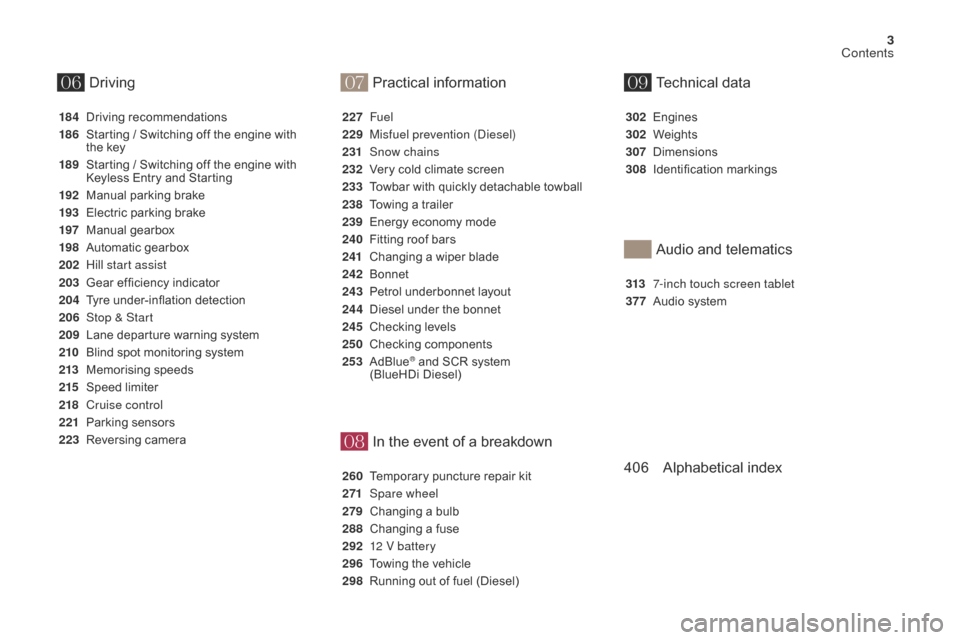
07
08
0609
3
DS4_en_Chap00a_sommaire_ed01-2016
In the event of a breakdown
184 Driving recommendations
186
S
tarting / Switching off the engine with
the key
189
S
tarting / Switching off the engine with
Keyless Entry and Starting
192
M
anual parking brake
193
E
lectric parking brake
197
M
anual gearbox
198
A
utomatic gearbox
202
H
ill start assist
203
G
ear ef ficiency indicator
204
T
yre under-inflation detection
206
St
op & Start
209
L
ane departure warning system
210
B
lind spot monitoring system
213
M
emorising speeds
215
Spe
ed limiter
218
C
ruise control
221
P
arking sensors
223
R
eversing camera 227
Fuel
229
M
isfuel prevention (Diesel)
231
S
now chains
232
V
ery cold climate screen
233
T
owbar with quickly detachable towball
238
T
owing a trailer
239
E
nergy economy mode
240
F
itting roof bars
241
C
hanging a wiper blade
242
B
onnet
243
Pe
trol underbonnet layout
244
D
iesel under the bonnet
245
C
hecking levels
250
Ch
ecking components
253
Ad
Blue
® and SCR system
(BlueHDi Diesel)
260
T
emporary puncture repair kit
271
S
pare wheel
279
C
hanging a bulb
288
C
hanging a fuse
292
1
2 V battery
296
T
owing the vehicle
298
R
unning out of fuel (Diesel) 302
E
ngines
302
We
ights
307
D
imensions
308
I
dentification markings
313
7
-inch touch screen tablet
377
A
udio system
Driving
Technical data
Practical information
Audio and telematics
Alphabetical index
406
Contents
Page 6 of 421
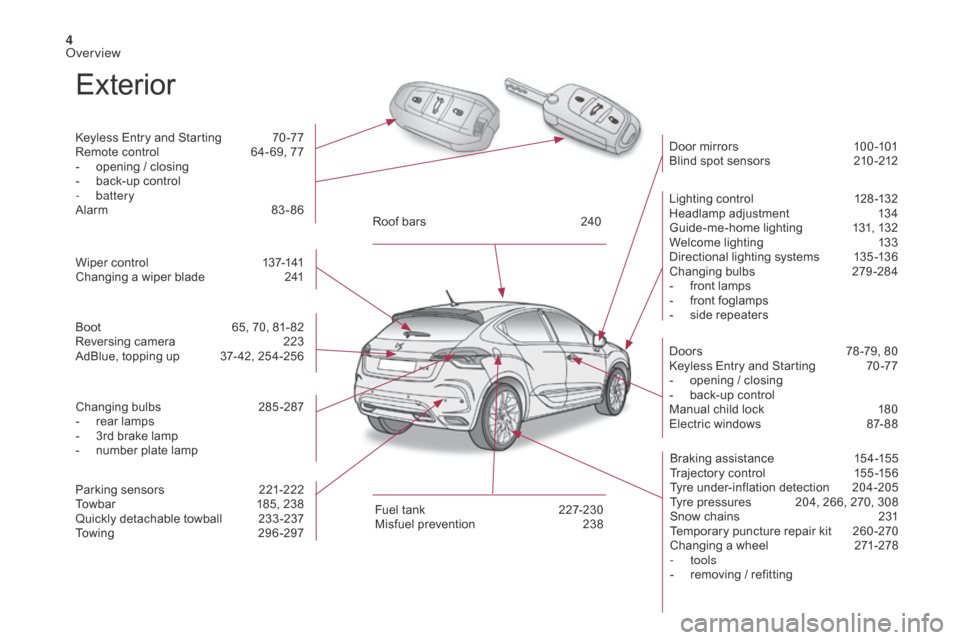
4
DS4_en_Chap00b_vue-ensemble_ed01-2016
Exterior
Keyless Entry and Starting 70 -77
Remote control 6 4- 69, 77
-
o
pening / closing
-
b
ack-up control
-
battery
Alarm
8
3-86 Lighting control
1
28 -132
Headlamp adjustment
1
34
Guide-me-home lighting
1
31, 132
Welcome lighting
1
33
Directional lighting systems
1
35 -136
Changing bulbs
2
79-284
-
f
ront lamps
-
f
ront foglamps
-
s
ide repeaters
Wiper control
1
37-141
Changing a wiper blade
2
41 Door mirrors
1 00 -101
Blind spot sensors
2
10 -212
Doors
7
8 -79, 80
Keyless Entry and Starting
7
0 -77
-
o
pening / closing
-
b
ack-up control
Manual child lock
1
80
Electric windows
87
- 88
Fuel tank
2
27-230
Misfuel prevention
2
38
Roof bars
2
40
Braking assistance
1
54-155
Trajectory control
1
55 -156
Tyre under-inflation detection
2
04-205
Tyre pressures
2
04, 266, 270, 308
Snow chains
2
31
Temporary puncture repair kit
2
60 -270
Changing a wheel
2
71-278
-
tools
-
r
emoving / refitting
Boot
6
5, 70, 81- 82
Reversing camera
2
23
AdBlue, topping up
3
7- 42, 254-256
Changing bulbs
2
85-287
-
r
ear lamps
-
3
rd brake lamp
-
n
umber plate lamp
Parking sensors
2
21-222
Towbar
1
85, 238
Quickly detachable towball
2
33 -237
Towing
29
6-297
Over view
Page 187 of 421
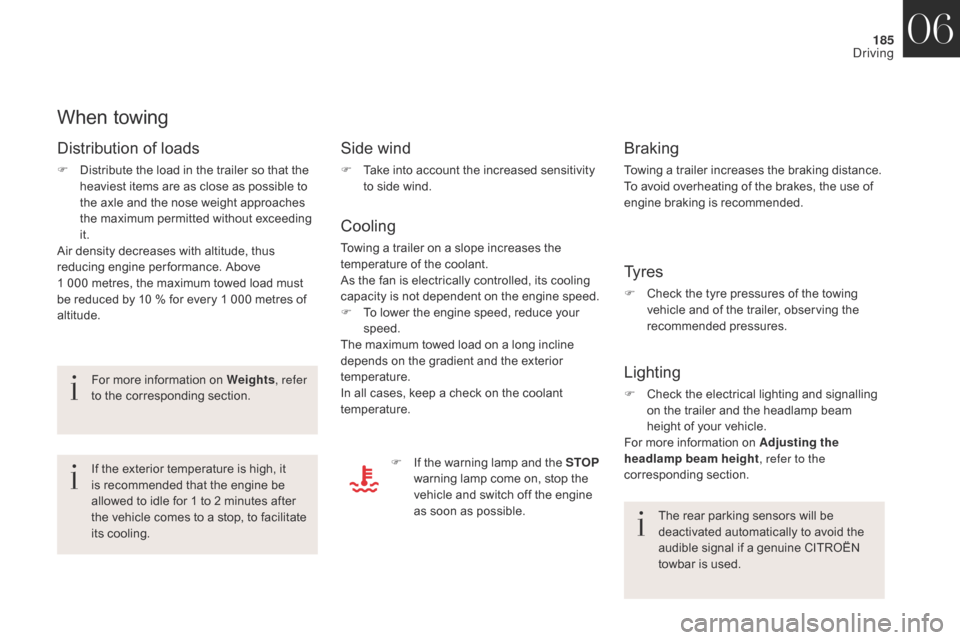
185
DS4_en_Chap06_conduite_ed01-2016
When towing
Distribution of loads
F Distribute the load in the trailer so that the heaviest items are as close as possible to
the axle and the nose weight approaches
the maximum permitted without exceeding
it.
Air density decreases with altitude, thus
reducing engine per formance. Above
1
000 metres, the maximum towed load must
be reduced by 10
% for every 1 000 metres of
altitude.
Side wind
F Take into account the increased sensitivity to side wind.
Cooling
Towing a trailer on a slope increases the
temperature of the coolant.
As the fan is electrically controlled, its cooling
capacity is not dependent on the engine speed.
F
T
o lower the engine speed, reduce your
speed.
The maximum towed load on a long incline
depends on the gradient and the exterior
temperature.
In all cases, keep a check on the coolant
temperature.
F
I
f the warning lamp and the STOP
warning lamp come on, stop the
vehicle and switch off the engine
as soon as possible.
Braking
Towing a trailer increases the braking distance.
To avoid overheating of the brakes, the use of
engine braking is recommended.
Ty r e s
F Check the tyre pressures of the towing vehicle and of the trailer, observing the
recommended pressures.
Lighting
F Check the electrical lighting and signalling on the trailer and the headlamp beam
height of your vehicle.
For more information on Adjusting the
headlamp beam height , refer to the
corresponding section.
For more information on Weights
, refer
to the corresponding section.
The rear parking sensors will be
deactivated automatically to avoid the
audible signal if a genuine CITROËN
towbar is used.
If the exterior temperature is high, it
is recommended that the engine be
allowed to idle for 1 to 2 minutes after
the vehicle comes to a stop, to facilitate
its cooling.
06
Driving
Page 214 of 421
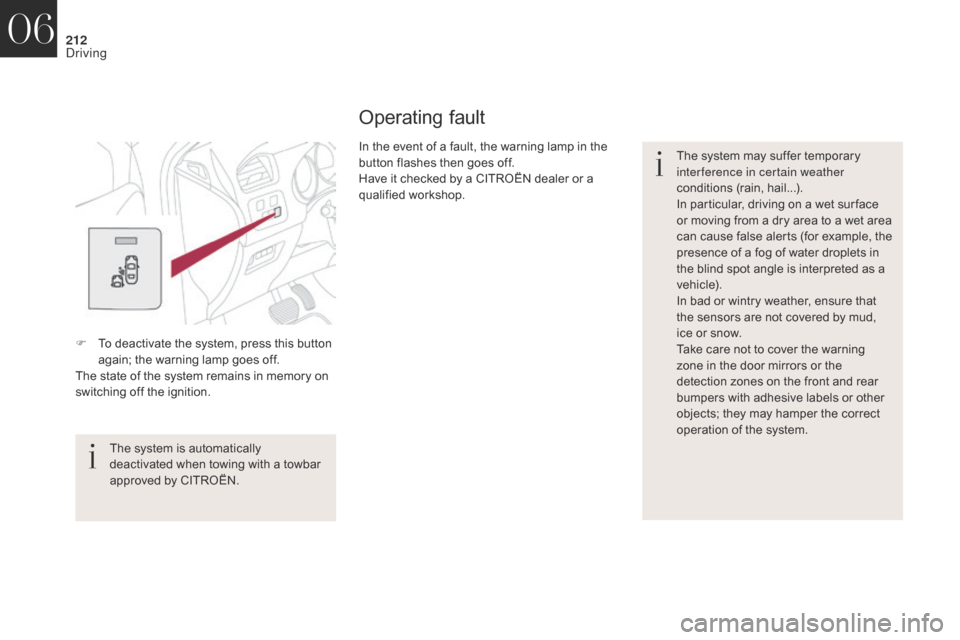
212
DS4_en_Chap06_conduite_ed01-2016
Operating fault
The system may suffer temporary
interference in certain weather
conditions (rain, hail...).
In particular, driving on a wet sur face
or moving from a dry area to a wet area
can cause false alerts (for example, the
presence of a fog of water droplets in
the blind spot angle is interpreted as a
vehicle).
In bad or wintry weather, ensure that
the sensors are not covered by mud,
ice or snow.
Take care not to cover the warning
zone in the door mirrors or the
detection zones on the front and rear
bumpers with adhesive labels or other
objects; they may hamper the correct
operation of the system.
F
T
o deactivate the system, press this button
again; the warning lamp goes off.
The state of the system remains in memory on
switching off the ignition.
The system is automatically
deactivated when towing with a towbar
approved by CITROËN. In the event of a fault, the warning lamp in the
button flashes then goes off.
Have it checked by a CITROËN dealer or a
qualified workshop.
06
Driving
Page 224 of 421
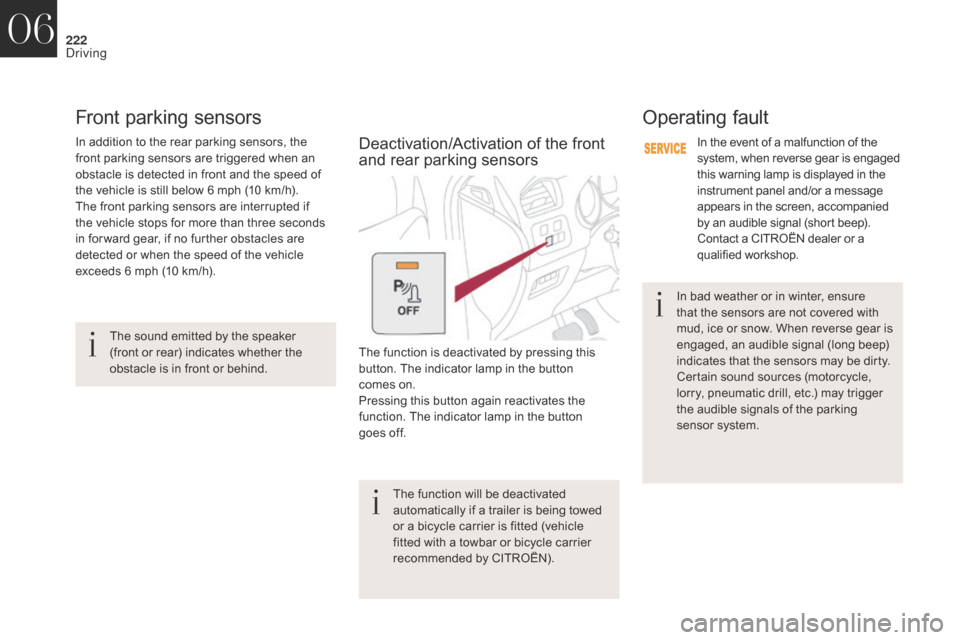
222
DS4_en_Chap06_conduite_ed01-2016
Front parking sensorsOperating fault
In the event of a malfunction of the
system, when reverse gear is engaged
this warning lamp is displayed in the
instrument panel and/or a message
appears in the screen, accompanied
by an audible signal (short beep).
Contact a CITROËN dealer or a
qualified workshop.
In addition to the rear parking sensors, the
front parking sensors are triggered when an
obstacle is detected in front and the speed of
the vehicle is still below 6 mph (10 km/h).
The front parking sensors are interrupted if
the vehicle stops for more than three seconds
in for ward gear, if no further obstacles are
detected or when the speed of the vehicle
exceeds 6 mph (10 km/h).
The function will be deactivated
automatically if a trailer is being towed
or a bicycle carrier is fitted (vehicle
fitted with a towbar or bicycle carrier
recommended by CITROËN).In bad weather or in winter, ensure
that the sensors are not covered with
mud, ice or snow. When reverse gear is
engaged, an audible signal (long beep)
indicates that the sensors may be dirty.
Certain sound sources (motorcycle,
lorry, pneumatic drill, etc.) may trigger
the audible signals of the parking
sensor system.Deactivation/Activation of the front
and rear parking sensors
The function is deactivated by pressing this
button. The indicator lamp in the button
comes
on.
Pressing this button again reactivates the
function. The indicator lamp in the button
goes
off.
The sound emitted by the speaker
(front or rear) indicates whether the
obstacle is in front or behind.
06
Driving
Page 235 of 421
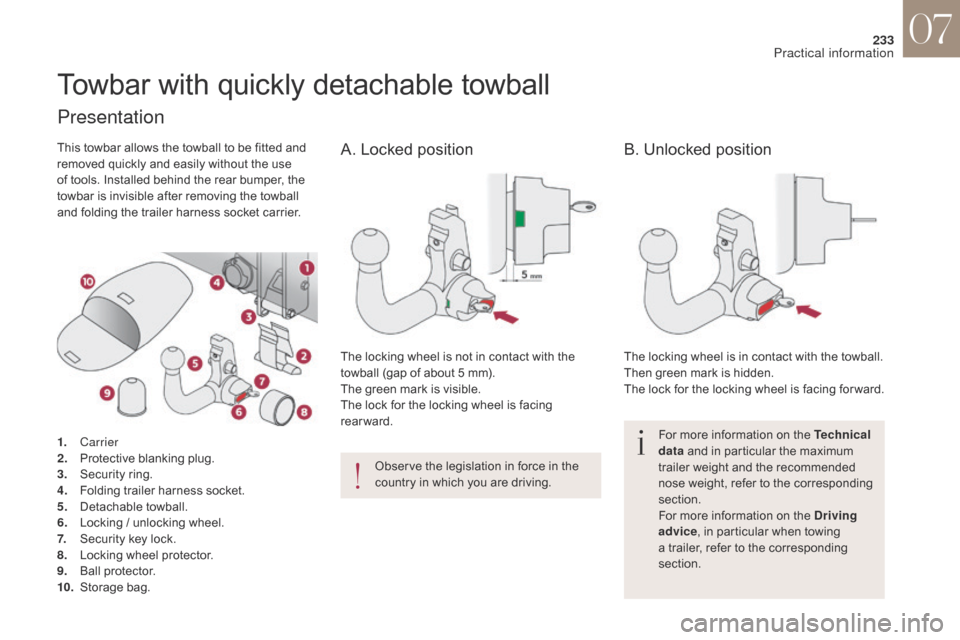
233
DS4_en_Chap07_info-pratiques_ed01-2016
Towbar with quickly detachable towball
For more information on the Technical
data and in particular the maximum
trailer weight and the recommended
nose weight, refer to the corresponding
section.
For more information on the Driving
advice , in particular when towing
a trailer, refer to the corresponding
section.
Observe the legislation in force in the
country in which you are driving.
Presentation
1.
Carrier
2. P rotective blanking plug.
3.
S
ecurity ring.
4.
F
olding trailer harness socket.
5.
D
etachable towball.
6.
L
ocking / unlocking wheel.
7.
S
ecurity key lock.
8.
L
ocking wheel protector.
9.
Ba
ll protector.
10.
St
orage bag. The locking wheel is not in contact with the
towball (gap of about 5 mm).
The green mark is visible.
The lock for the locking wheel is facing
rearward.
The locking wheel is in contact with the towball.
Then green mark is hidden.
The lock for the locking wheel is facing for ward.
This towbar allows the towball to be fitted and
removed quickly and easily without the use
of tools. Installed behind the rear bumper, the
towbar is invisible after removing the towball
and folding the trailer harness socket carrier.
A. Locked position
B. Unlocked position
07
Practical information
Page 237 of 421
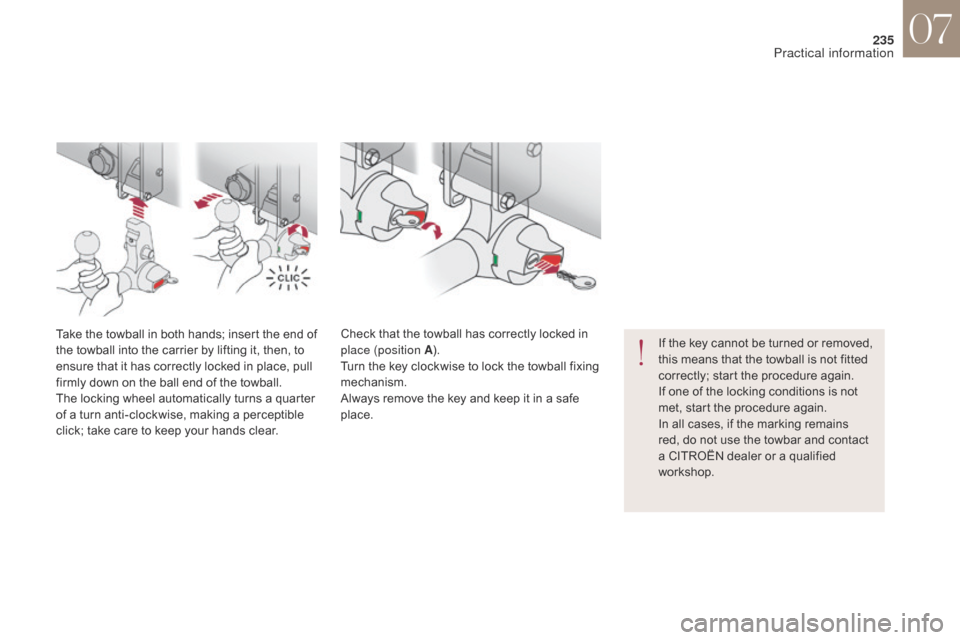
235
DS4_en_Chap07_info-pratiques_ed01-2016
If the key cannot be turned or removed,
this means that the towball is not fitted
correctly; start the procedure again.
If one of the locking conditions is not
met, start the procedure again.
In all cases, if the marking remains
red, do not use the towbar and contact
a CITROËN dealer or a qualified
workshop.
Take the towball in both hands; insert the end of
the towball into the carrier by lifting it, then, to
ensure that it has correctly locked in place, pull
firmly down on the ball end of the towball.
The locking wheel automatically turns a quarter
of a turn anti-clockwise, making a perceptible
click; take care to keep your hands clear.
Check that the towball has correctly locked in
place (position A
).
Turn the key clockwise to lock the towball fixing
mechanism.
Always remove the key and keep it in a safe
place.
07
Practical information
Page 239 of 421
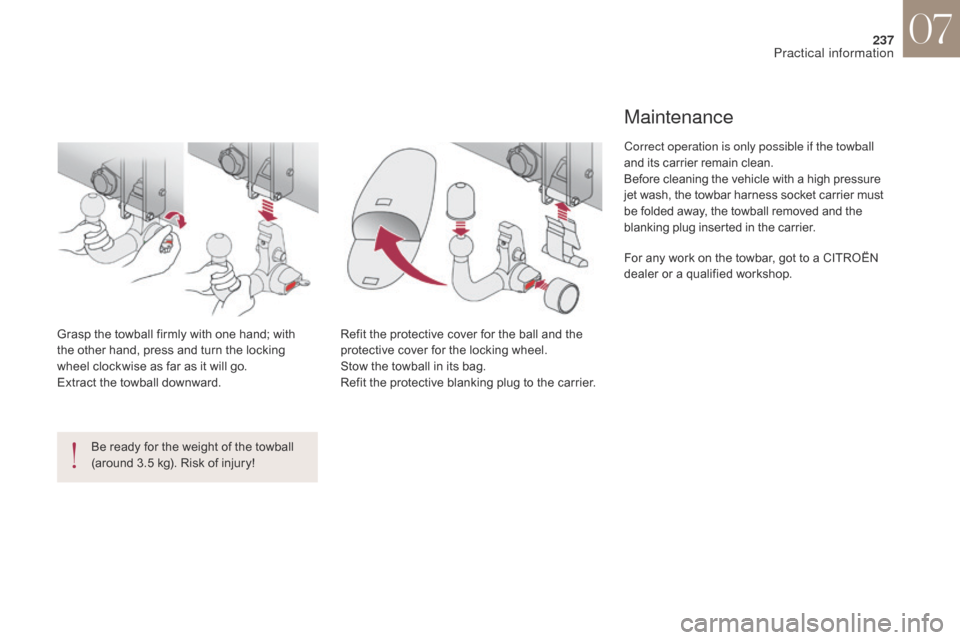
237
DS4_en_Chap07_info-pratiques_ed01-2016
Be ready for the weight of the towball
(around 3.5 kg). Risk of injury!
Grasp the towball firmly with one hand; with
the other hand, press and turn the locking
wheel
clockwise as far as it will go.
Extract the towball downward. Refit the protective cover for the ball and the
protective cover for the locking wheel.
Stow the towball in its bag.
Refit the protective blanking plug to the carrier.
Maintenance
Correct operation is only possible if the towball
and its carrier remain clean.
Before cleaning the vehicle with a high pressure
jet wash, the towbar harness socket carrier must
be folded away, the towball removed and the
blanking plug inserted in the carrier.
For any work on the towbar, got to a CITROËN
dealer or a qualified workshop.
07
Practical information
Page 240 of 421
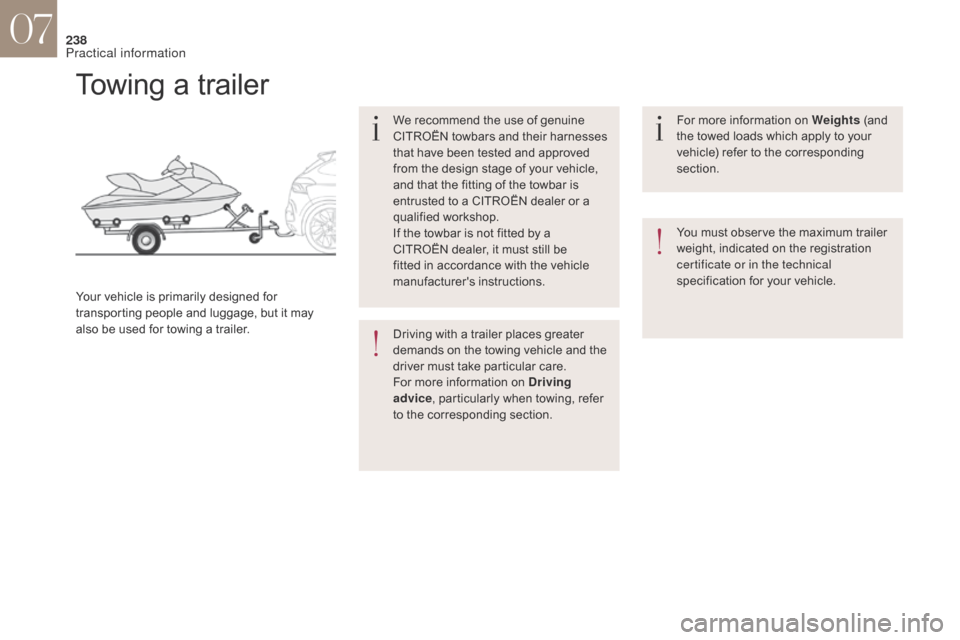
238
Towing a trailer
We recommend the use of genuine
CITROËN towbars and their harnesses
that have been tested and approved
from the design stage of your vehicle,
and that the fitting of the towbar is
entrusted to a CITROËN dealer or a
qualified workshop.
If the towbar is not fitted by a
CITROËN dealer, it must still be
fitted in accordance with the vehicle
manufacturer's instructions.
Your vehicle is primarily designed for
transporting people and luggage, but it may
also be used for towing a trailer. Driving with a trailer places greater
demands on the towing vehicle and the
driver must take particular care.
For more information on Driving
advice, particularly when towing, refer
to the corresponding section. For more information on Weights
(and
the towed loads which apply to your
vehicle) refer to the corresponding
section.
You must observe the maximum trailer
weight, indicated on the registration
certificate or in the technical
specification for your vehicle.
07
Practical information
Page 304 of 421
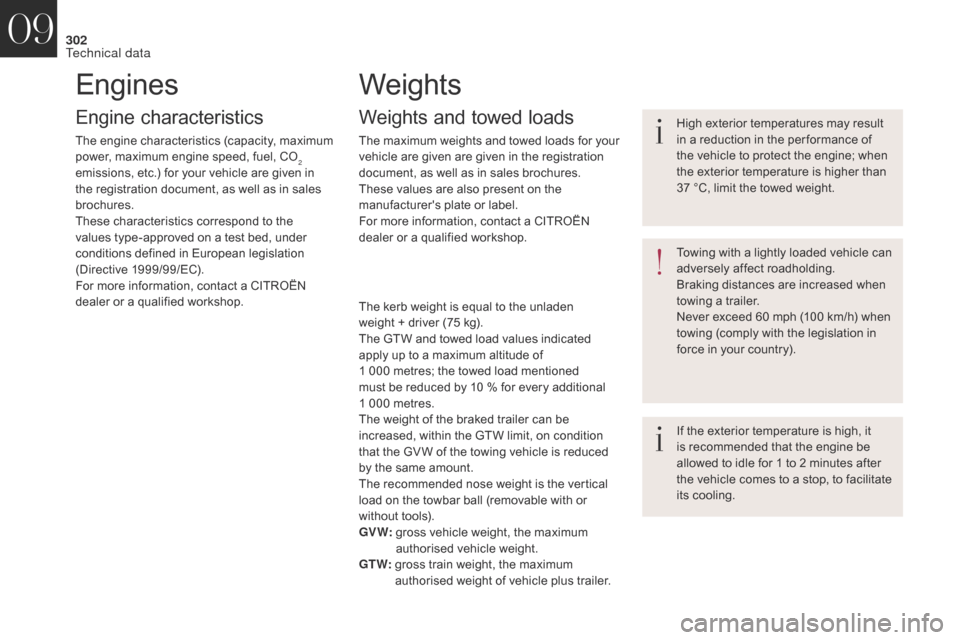
302
DS4_en_Chap09_caracteristiques_ed01-2016
Engines
Engine characteristics
The engine characteristics (capacity, maximum
power, maximum engine speed, fuel, CO
2
emissions, etc.) for your vehicle are given in
the registration document, as well as in sales
brochures.
These characteristics correspond to the
values type-approved on a test bed, under
conditions defined in European legislation
(Directive
1
999/99/EC).
For more information, contact a CITROËN
dealer or a qualified workshop.
Weights
Weights and towed loads
The maximum weights and towed loads for your
vehicle are given are given in the registration
document, as well as in sales brochures.
These values are also present on the
manufacturer's plate or label.
For more information, contact a CITROËN
dealer or a qualified workshop.
The kerb weight is equal to the unladen
weight
+ driver (75 kg).
The GTW and towed load values indicated
apply up to a maximum altitude of
1
000 metres; the towed load mentioned
must be reduced by 10 % for every additional
1
000 metres.
The weight of the braked trailer can be
increased, within the GTW limit, on condition
that the GV W of the towing vehicle is reduced
by the same amount.
The recommended nose weight is the vertical
load on the towbar ball (removable with or
without tools).
GV W:
g
ross vehicle weight, the maximum
authorised vehicle weight.
GT W:
g
ross train weight, the maximum
authorised weight of vehicle plus trailer. High exterior temperatures may result
in a reduction in the per formance of
the vehicle to protect the engine; when
the exterior temperature is higher than
37
°C, limit the towed weight.
If the exterior temperature is high, it
is recommended that the engine be
allowed to idle for 1 to 2 minutes after
the vehicle comes to a stop, to facilitate
its cooling. Towing with a lightly loaded vehicle can
adversely affect roadholding.
Braking distances are increased when
towing a trailer.
Never exceed 60 mph (100 km/h) when
towing (comply with the legislation in
force in your country).
09
Technical data